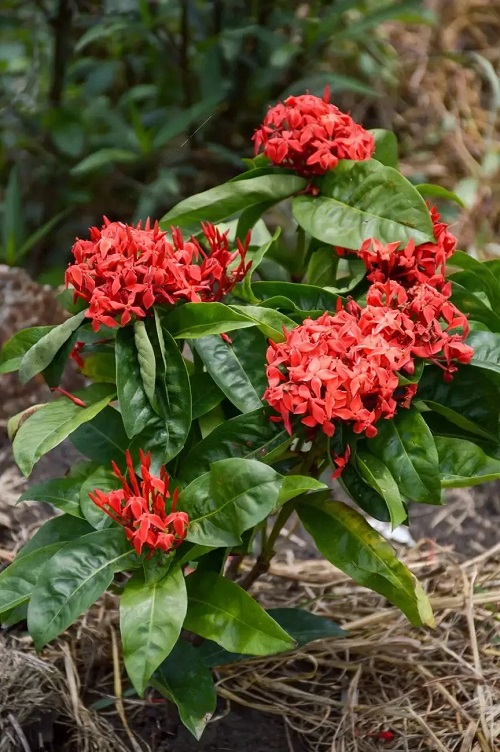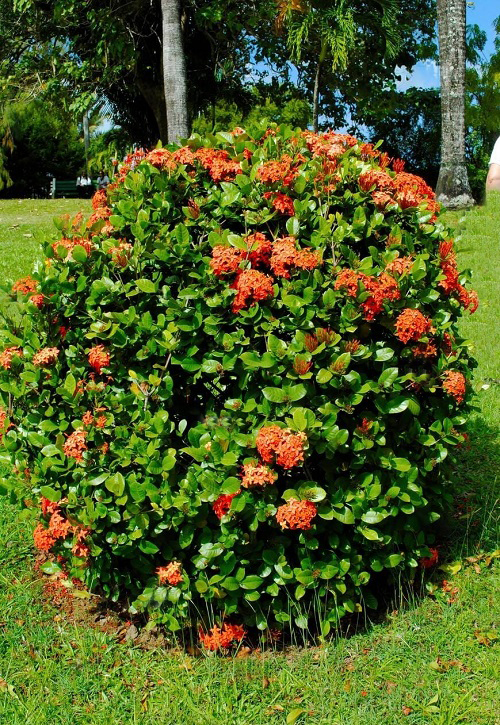Here’s everything about Ixora Maui Red Care and Growing Guide. This could be a perfect pick if you want a showstopper houseplant.
Ahoy there! Welcome to the world of Ixora Maui Red! This hybrid Ixora is like a vacation in a plant, with its vibrant, rich red flowers that bloom non-stop, making it an absolute stunner in any garden or living space. The best part? It’s low maintenance, so you can sit back, relax, and soak up all that tropical paradise without lifting a green thumb. So what are you waiting for? Add a pop of Maui Red to your life and bask in its everlasting sunshine. Read on to learn all about Ixora Maui Red Care and Growing Guide.
Learn How to Grow Goldfish Plant here
Propagating Ixora Maui Red
Follow these steps to grow baby Ixora Maui Red:
- Watch out for dark purple berries on the flowers, which sometimes contain seeds that are ready for their big break.
- Rinse off the pulp and soak the seeds overnight for a head start.
- Fill a 2-3-inches pot with seed starter mix, and plant the seeds, watering them thoroughly.
- Cover the pot with a plastic bag to create a mini greenhouse and place it in a warm area with moderate light.
- As soon as the seed germinates in 10-12 weeks, move your little sprout into brighter light and say goodbye to the bag.
Check out this One Secret to Grow Any Plant From a Cutting
Best Pot Size for Growing Ixora Maui Red
The best pot size for growing Ixora Maui Red would depend on the size of the plant. As a general guideline, an 8-10 inches deep and wide pot would be suitable for an average-sized Ixora Maui Red plant.
It is important to choose a pot that provides enough room for the plant’s roots to grow and spread.
Learn about the Plant Pot Sizes, Inches to Gallon, here
Requirements for Growing Ixora Maui Red

Light
Ixora plants require bright, indirect sunlight to thrive. Place them in a spot that gets four to six hours of bright sunlight each day. Avoid direct afternoon harsh sunlight, as this can burn the foliage and cause it to become dry and brittle.
Soil
Ixora plants prefer well-draining, acidic soil with a pH of 5.0 to 6.0. The soil should also be high in organic matter, such as compost or aged manure. Adding a layer of mulch around the base of the plant helps retain moisture and keep the soil cool.
Water
Ixora plants thrive best in moist, well-drained soil. Water the plant deeply and regularly during the summer months, allowing the soil to dry out slightly between waterings.
During the winter months, reduce watering, but do not let the soil completely dry out. If the leaves begin to wilt or droop, it is a sign that the plant is not getting enough water.
Adding a layer of mulch around the base of the plant can help retain moisture and keep the soil temperature even.
Check out these Signs of Overwatering & How to Save an Overwatered Plant
Temperature
Ixoras crave warm and humid environments and appreciate a temperature range of 60-90°F or 15-30°C. Keep the temperature above 40°F or 10°C at all times, and avoid placing it in areas with cold drafts, like near windows or air conditioners.
Humidity
Ixoras also love humidity above 50 percent. If growing indoors, keep it in a traditionally humid room in your home, like the kitchen or bathroom, or spritz it with water daily.
You can also invest in a small space humidifier to keep your Ixora and other tropical plants happy.
Here are Container Gardening Tips (Soil) That You Need To Know Now
Ixora Maui Red Care
Fertilizer
Ixora plants require liquid fertilizer that is high in nitrogen and potassium for healthy growth and flowering. A balanced fertilizer with a ratio of 10-10-10 or 20-20-20 can be used every two weeks during the growing season.
Be sure to apply the fertilizer according to the label instructions, as too much of it can burn the plant.
Pruning
Pruning an Ixora plant should be done in late winter or early spring before the plant begins to produce new growth.
Prune off any dead, damaged, or diseased branches and stems, as well as any branches that are growing in an unruly or uncontrolled manner. Pruning should be done with sharp, clean pruning shears.
Try to maintain the natural shape of the Ixora as much as possible. Once the pruning is complete, fertilize the Ixora with a balanced fertilizer.
Pests and Diseases
Pests:
-Aphids
-Mealybugs
-Scale Insects
-Thrips
Diseases:
-Anthracnose
-Leaf Spot
-Root Rot
-Rust
-Viral Diseases




